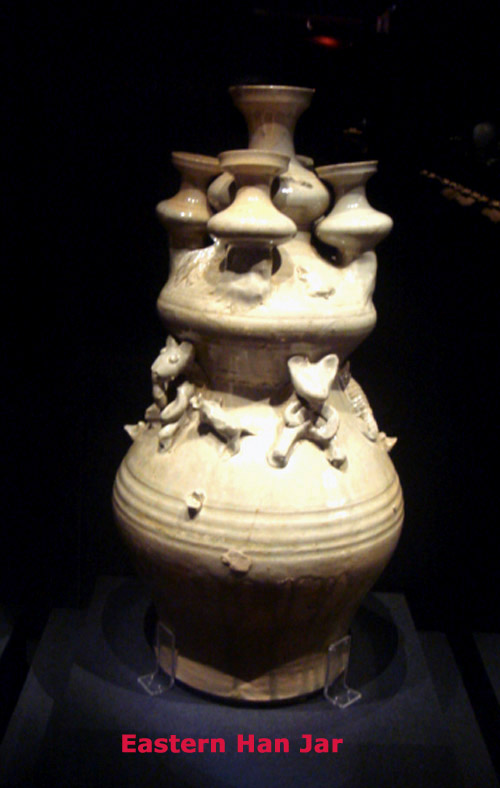
Eastern Han to Sui Porcelain
Mature greenware was finally produced near the end of Eastern Han Dynasty. The main decorative techniques used were incising, luting of molded motif. It was also popular to shape the vessels in animal forms. Another distinctive vessel is jar with multiple smaller jars on top of the big jar.

Major milestones in the history of porcelain production during the Eastern Han to Sui period included:
Greenware Production
Mature porcelain was finally produced in the Zhejiang province near the end of Eastern Han Dynasty after about 2000 years from the appearance of proto-porcelain in Shang Dynasty. Xiangyin (湘阴) in Hunan (湖南), Fengcheng (丰城) in Jiangxi (江西)and Yixing (宜兴) in Jiangsu (江苏) were areas which commenced porcelain production during the Han Dynasty.
The potters were able to achieve a good grayish green and smooth glaze. It showed good control of kiln firing. The porcelains were fired in dragon kilns (also sometime called serpentine or scorpion kiln). Kiln furniture such as trumpet, cylindrical shaped props, 3-prongs spurs and disc shaped setters were found in the firing chamber of the ancient Han kilns. The use of props was a technological improvement. In the past, many of the vessels such as jars showed sign of under-firing on lower portion of vessels. This was because the vessels were placed directly on the floor of the firing chamber. As heat travel upward, the lower portion of the vessels received less heat and could not be fired to the required temperature. By placing the vessels on a disc setter which rested on top of the props, the vessels were raised higher. The disc setter was to ensure that any running of the glaze would not resulted in the vessels adhering to the prop. The 3 prongs spur were used as separator for stacking of bowls/plates.
The production continued to flourish during the 3 Kingdoms to the 6 dynasties period. The centre of production was Shangyu in Zhejiang. The utilitarian vessels most frequently associated with this period are in animal-form: such as sheep and lion shape candle stands, lamps which looked like bears, frog-shaped water-droppers and bird shape cups,. They are both artistic and functional. There were also large number of funerary wares such as model granaries , stoves, wells, mills were produced.
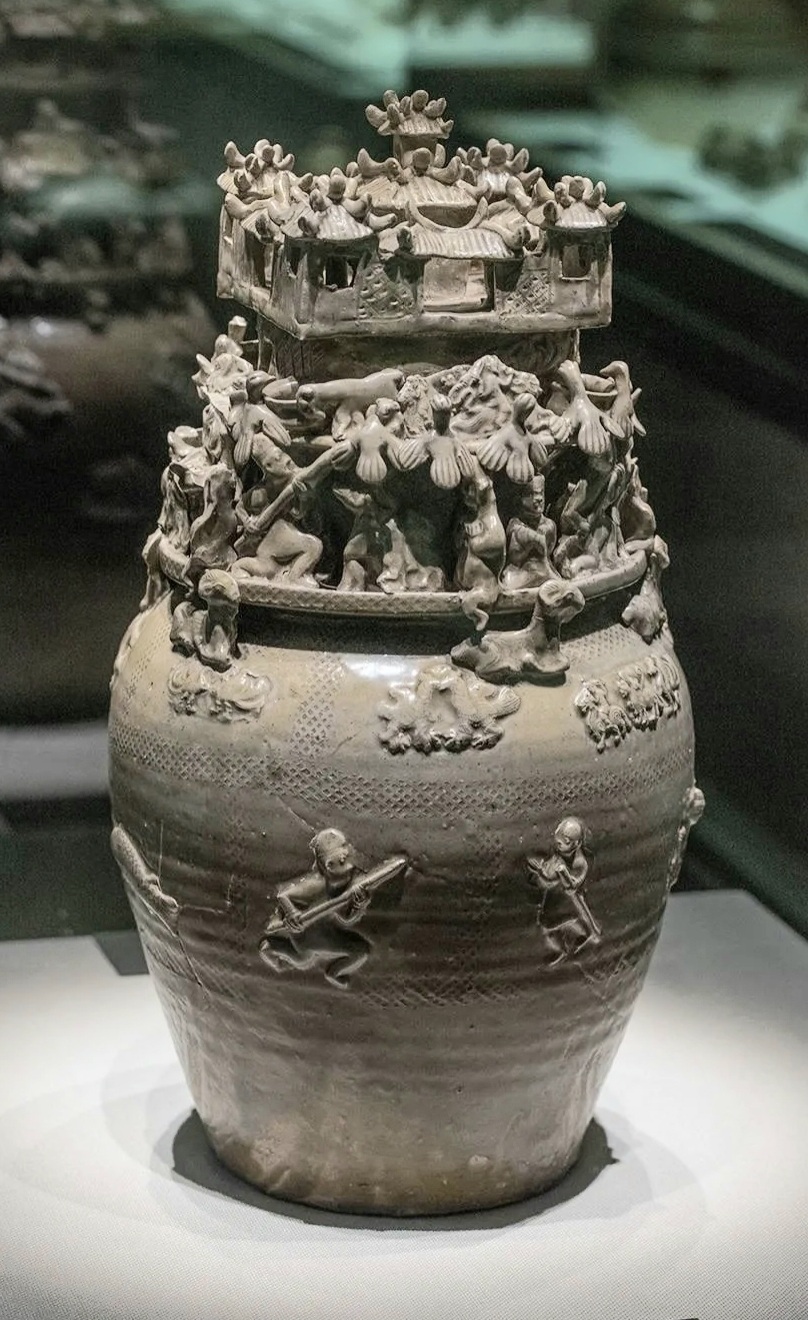 |
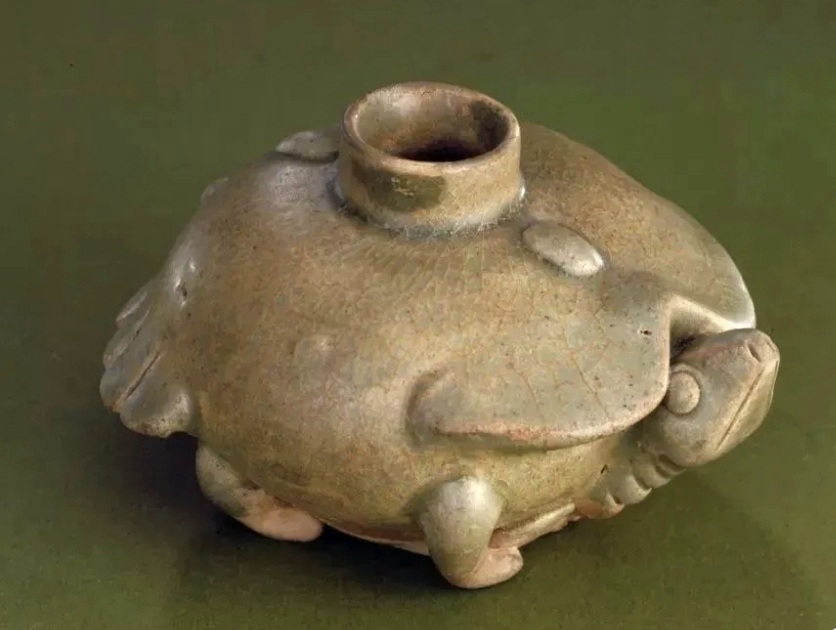 |
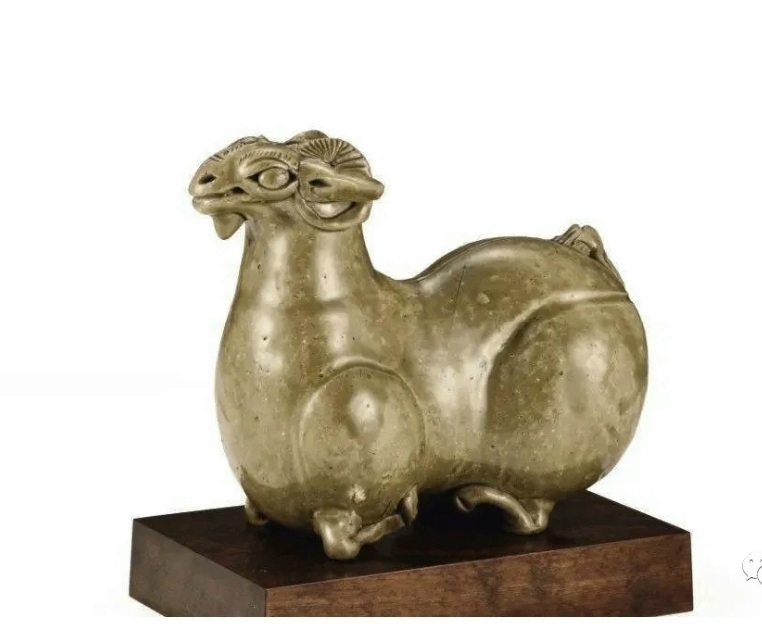 |
| Jin Period Yue wares |
The Eastern Jin and north/south dynasties was a period of upheavals and the economy suffered. The ceramic industry was adversely affected. Shangyu was reduced from a booming production centre to an area with few scattered small kilns. The kilns produced mainly bowls, dishes, cups with ears, cup stands, alms bowls, jars, ewers, inkstones, chicken head ewers and other wares for daily use.
The decorative motifs include circular bands and iron brown painted spots. Those impressed diamond bands were hardly used by Eastern Jin.
The term "old yue ware" was used to refer Zhejiang greenware of Eastern Han to 6 dynasties. This is to distinguished them from the Yue wares of Tang/ Song.
For more on old Yue wares, please read this article: Pre Tang Yue wares
Two other important Zhejiang greenware production sites were Ou kiln (瓯窑) in Wenzhou (温州) and Wuzhou (婺洲) in Jinhua (金华). The distinctive feature of wuzhou greenware is its more light whitish green glaze. For greenware from Wuzhou, a lay of slip is usually detectable below the green glaze.
Yuezhou kiln (岳州窑)in Hunan Xiangyin (湖南湘阴)
Hunan Xiangyin Yuezhou kiln commenced porcelain production during Han dynasty. It entered its golden phase during Southern Dynasty period Many of the decorative elements of this period showed interesting distinct Buddhist and Middle Eastern influences. The crackled glaze is uneven but generally has a pleasing greenish colour tone. Archaeological findings revealed that during the Southern Dynasty period, the greenware of Yuezhou and Jiangxi Hongzhou were of excellent quality and likely enjoyed a larger market share as compared with Yue ware.
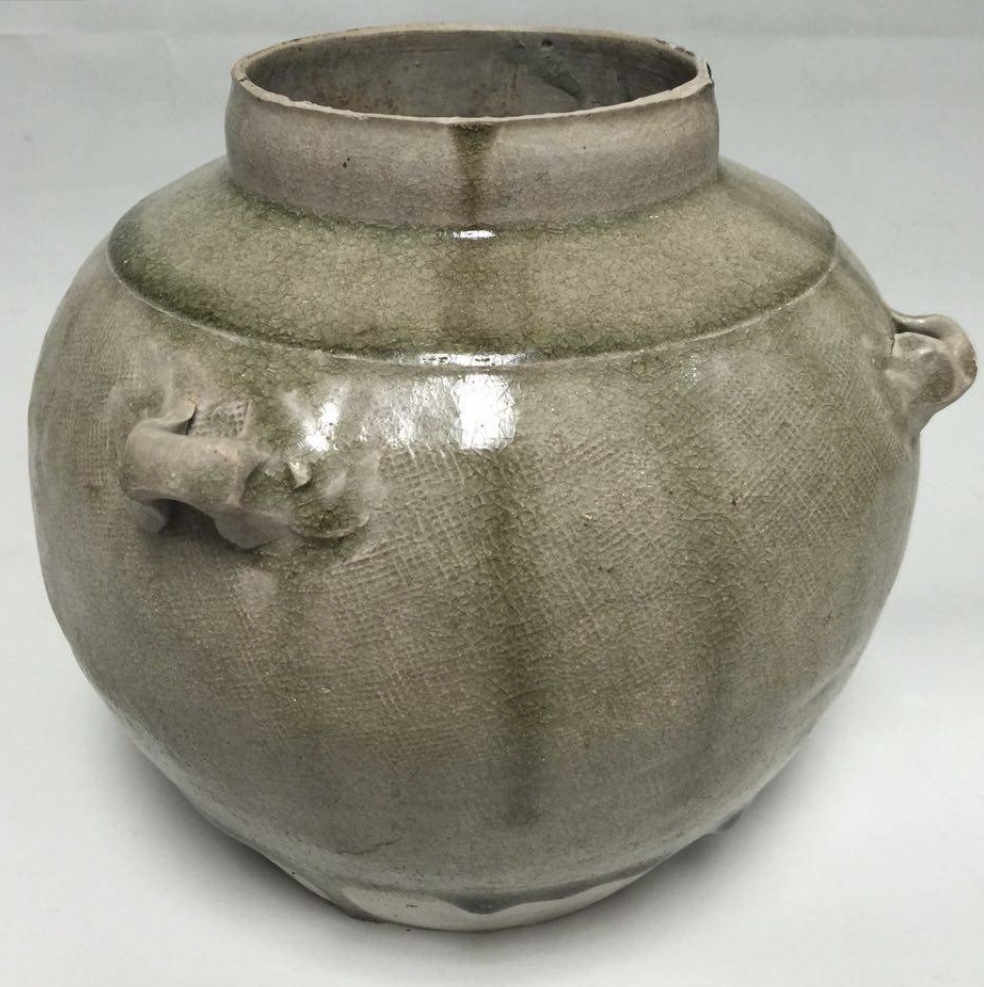 |
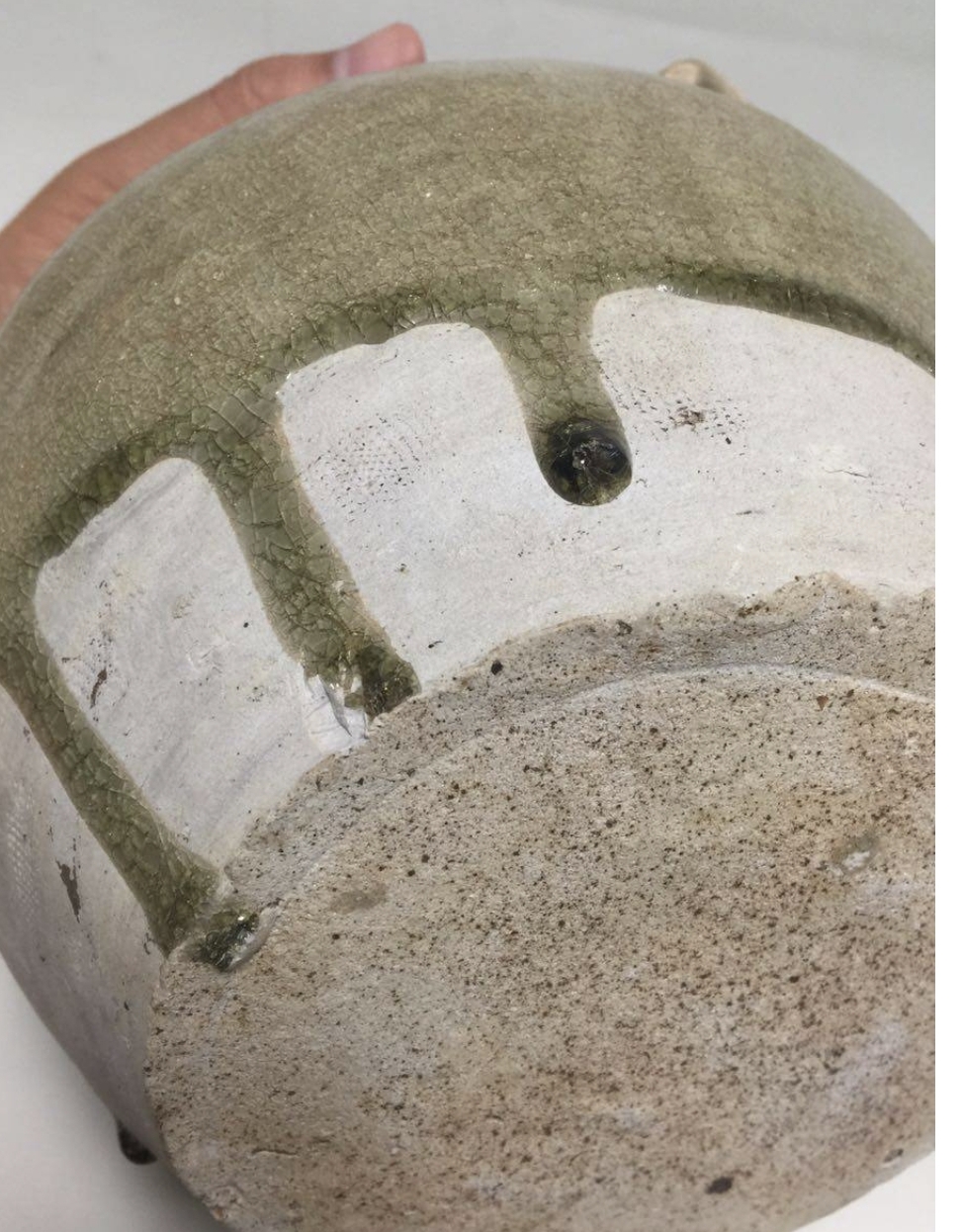 |
| Han Dynasty example of Yuezhou greenware |
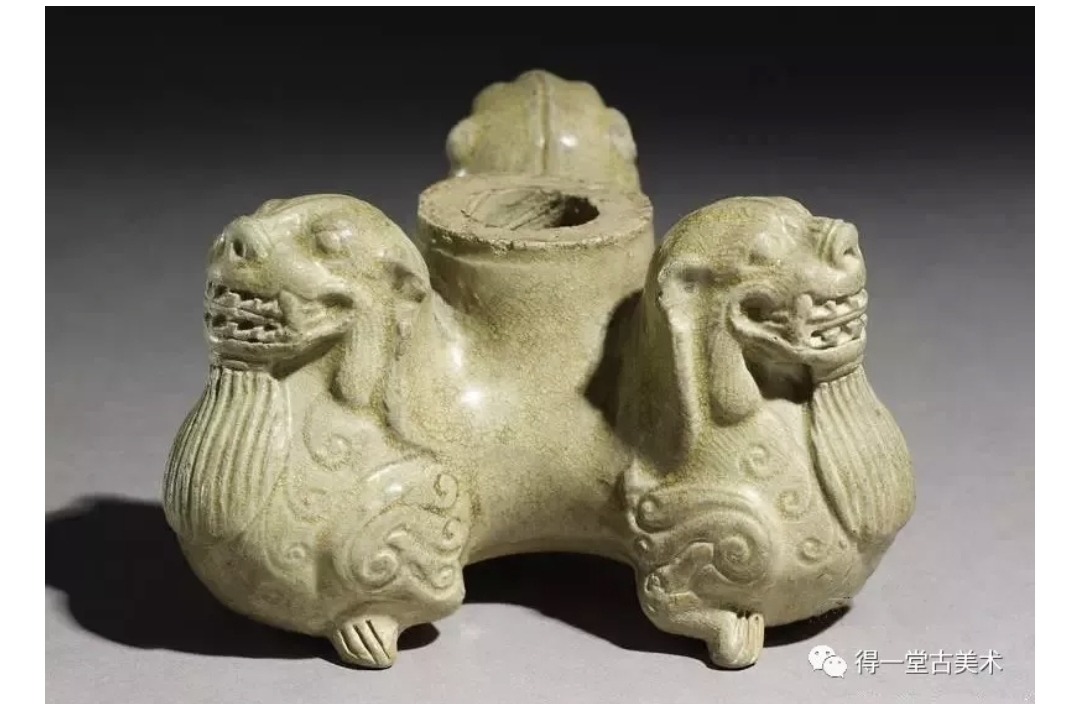 |
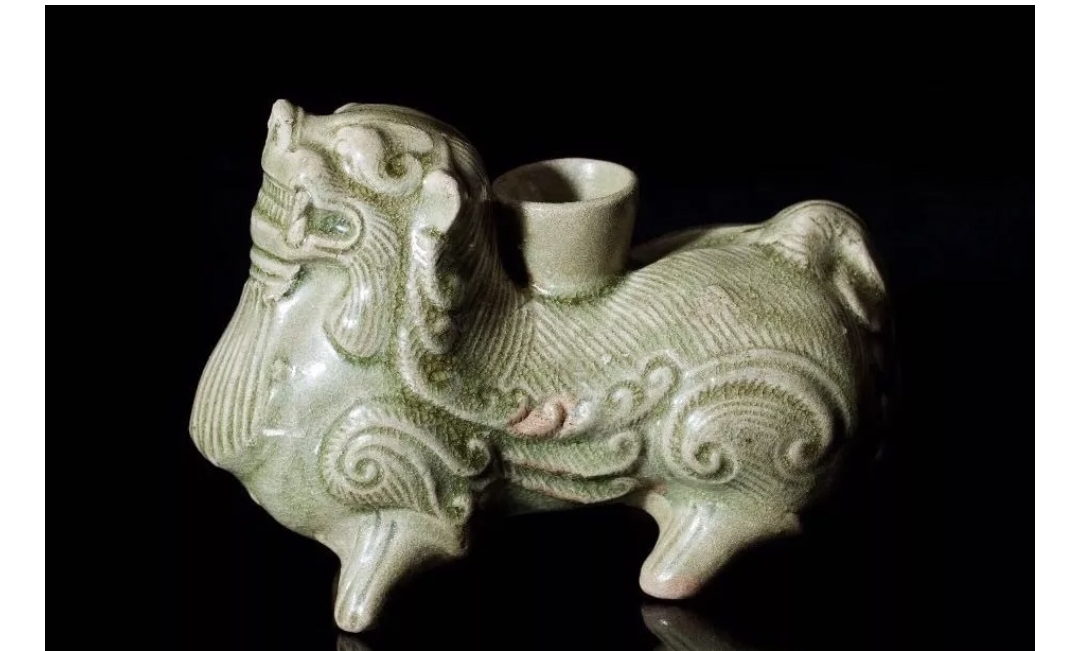 |
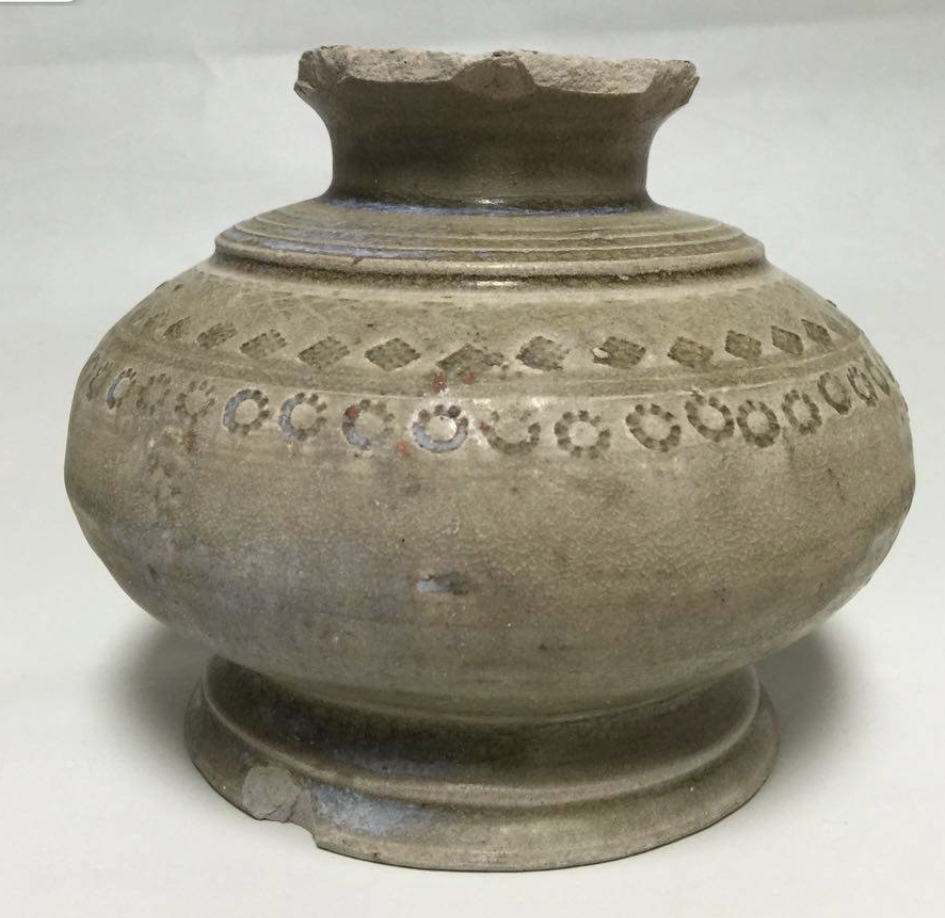 |
| Jin Example of Yuezhou ware |
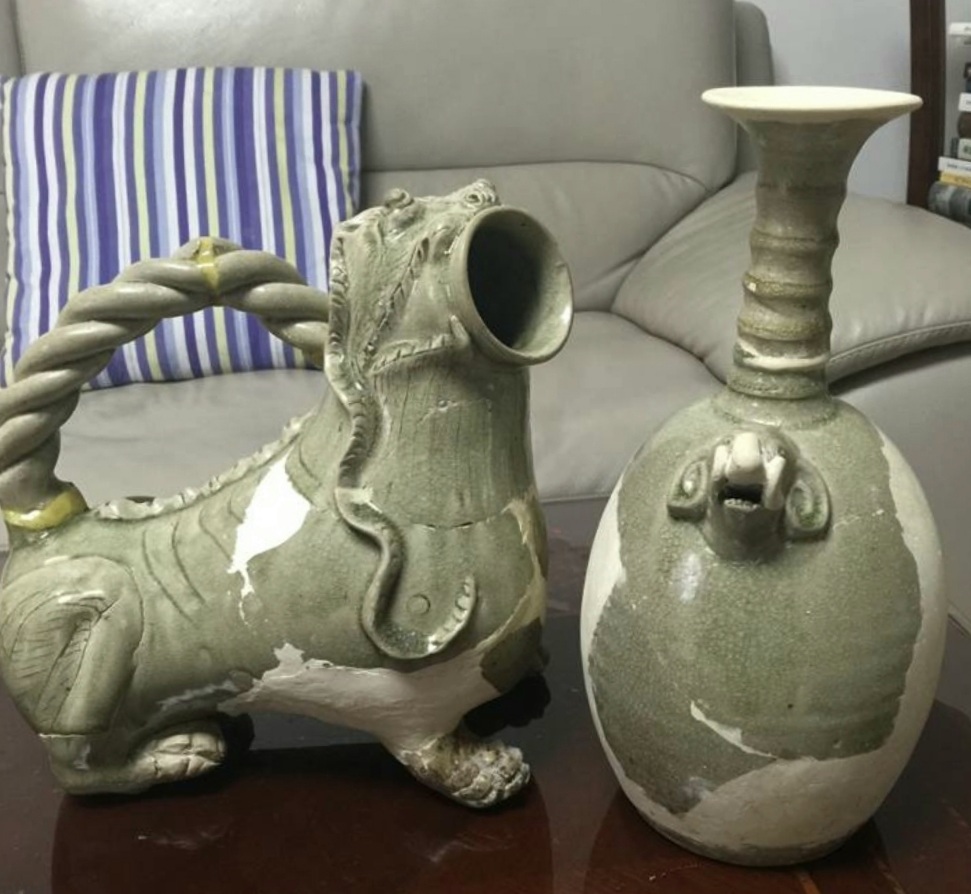 |
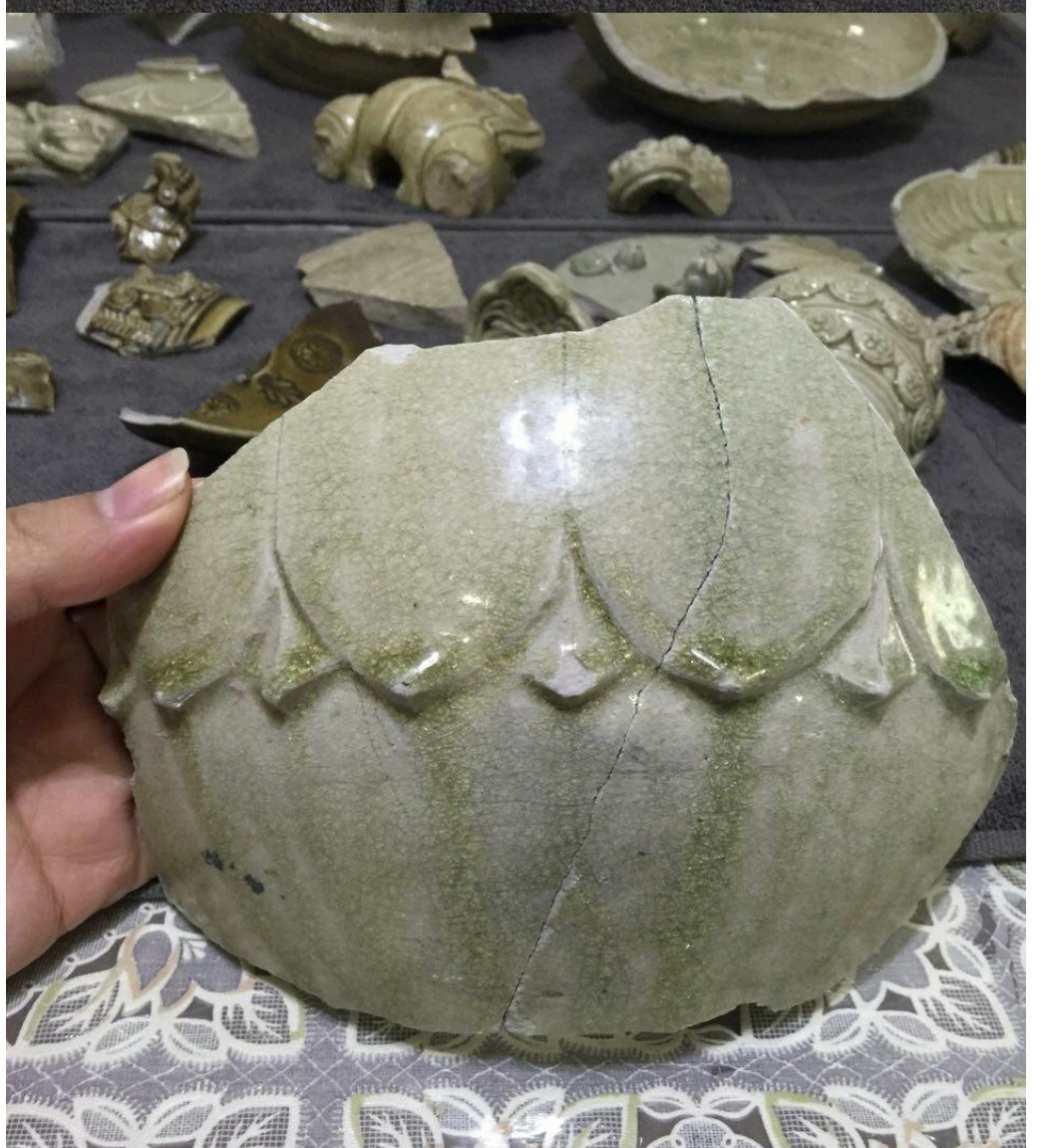 |
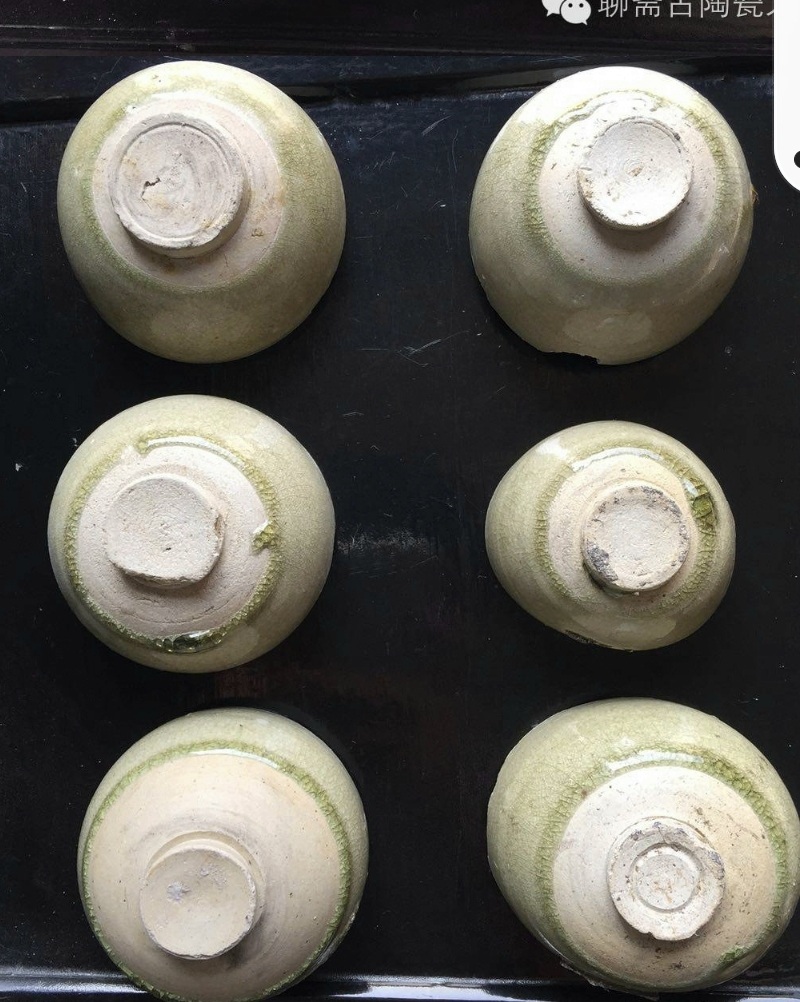 |
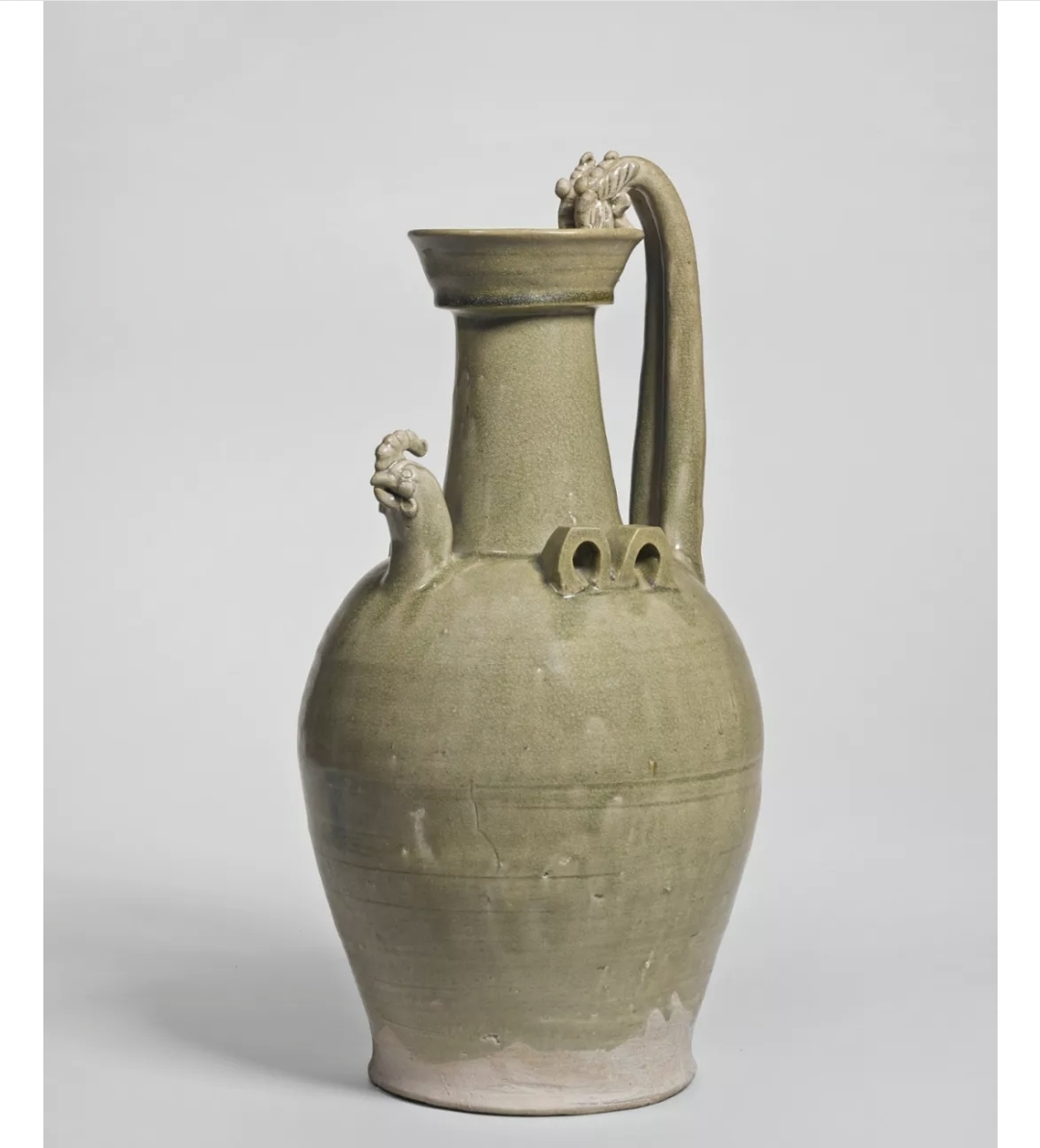 |
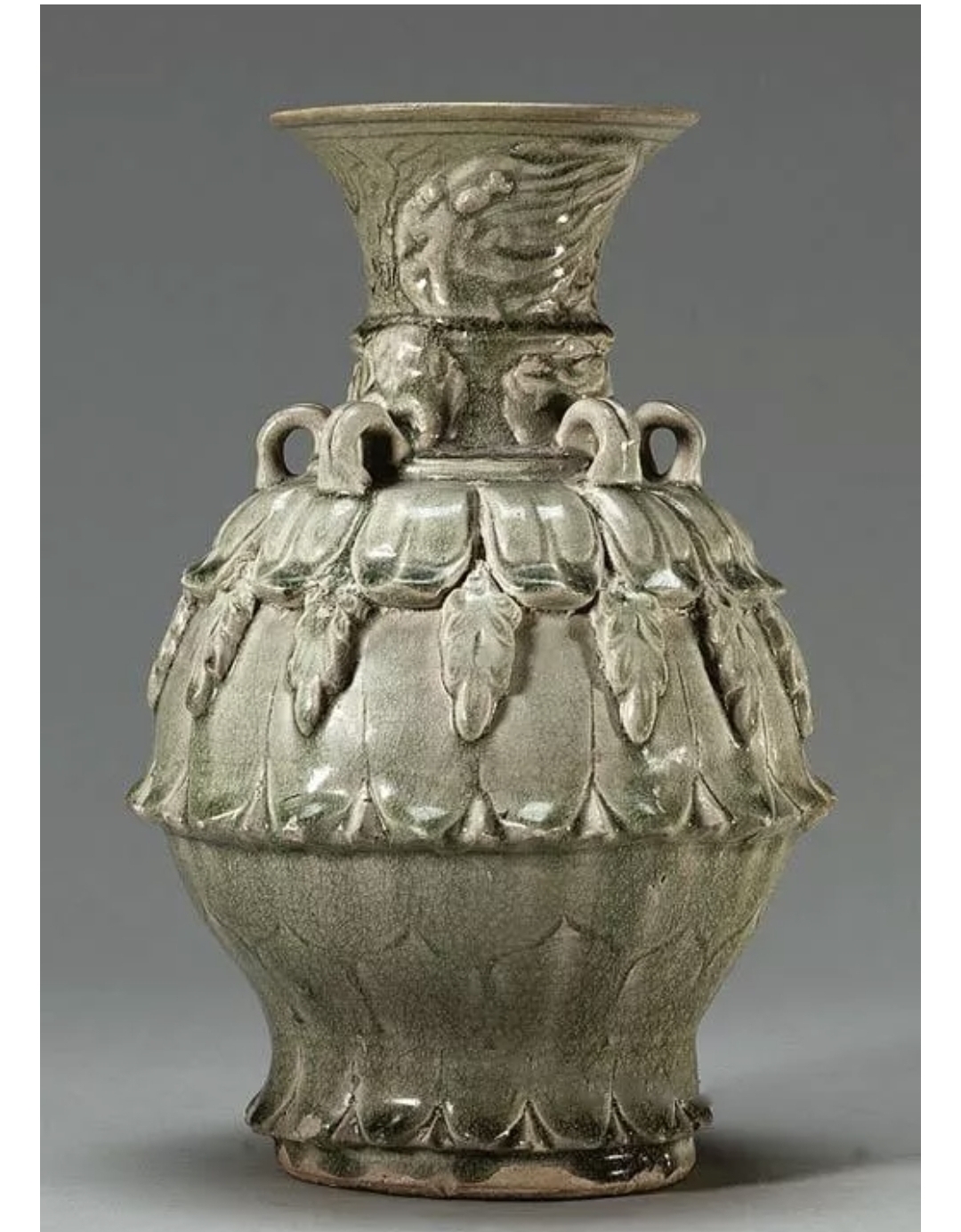 |
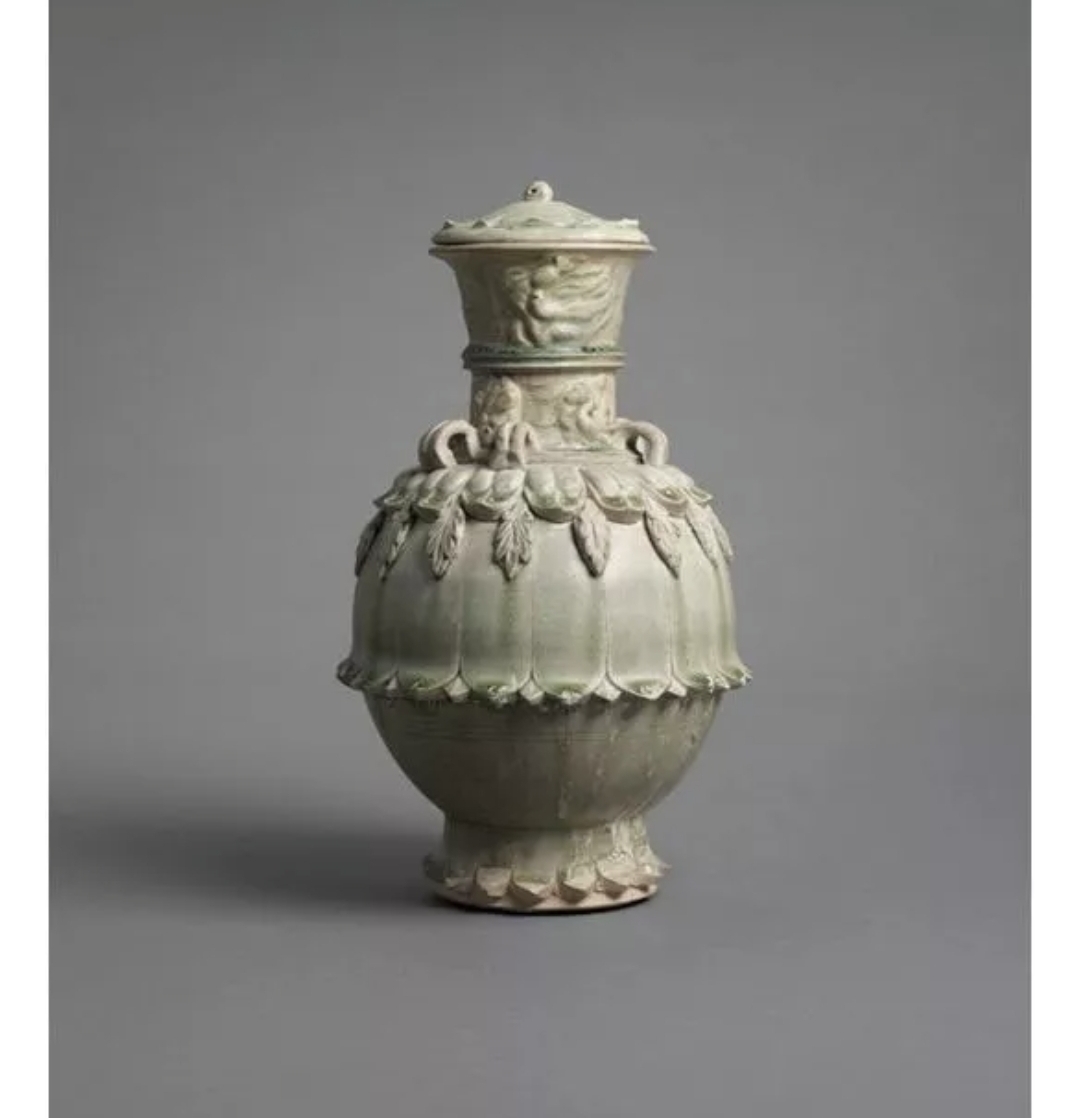 |
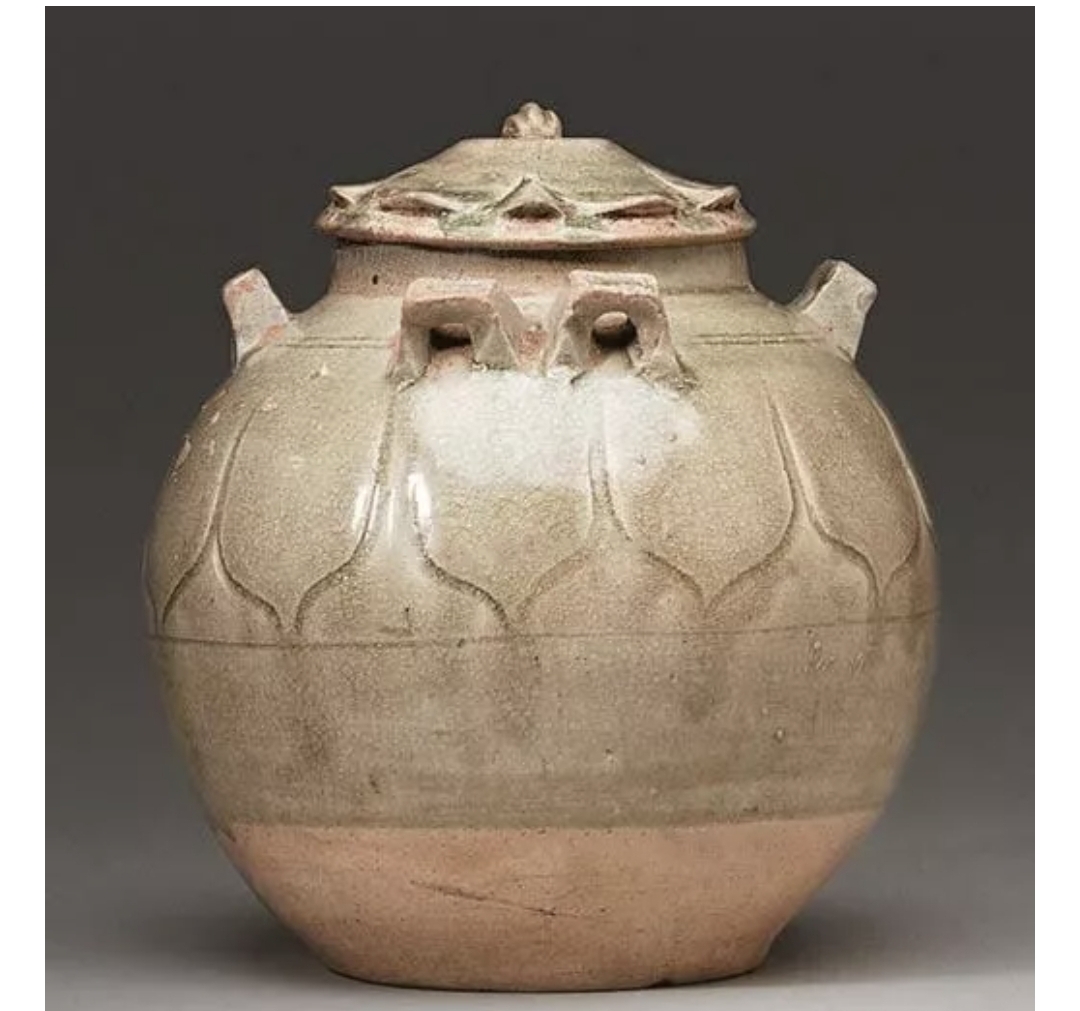 |
| Southern Dynasty examples of Yuezhou wares |
Jiangxi Feng Cheng (江西丰城) Hongzhou kiln (洪州窑)
In 1977, Southern Dynasties kiln sites were discovered in Luo Hu kiln (罗湖) in Jiangxi Feng Cheng (丰城) . Most have a rice yellowish colour There were small quantity with some with greenish or greenish yellow colour glaze. Glaze flakings and crackled glaze is a common feature. Fengcheng is located in ancient Tang Dynasty Hongzhou (洪洲) and is believed to be the location of the Hongzhou kiln mentioned in Lu Yu's (陆羽) treatise on tea (茶经). Further achaeological studyies revealed that the kilns in Feng Cheng commenced production during the Han Dynasty and entered its golden phase during the Southern Dynasties period. By the Tang period, the quality of its products deteriorated generally has a brownish green colour tone.
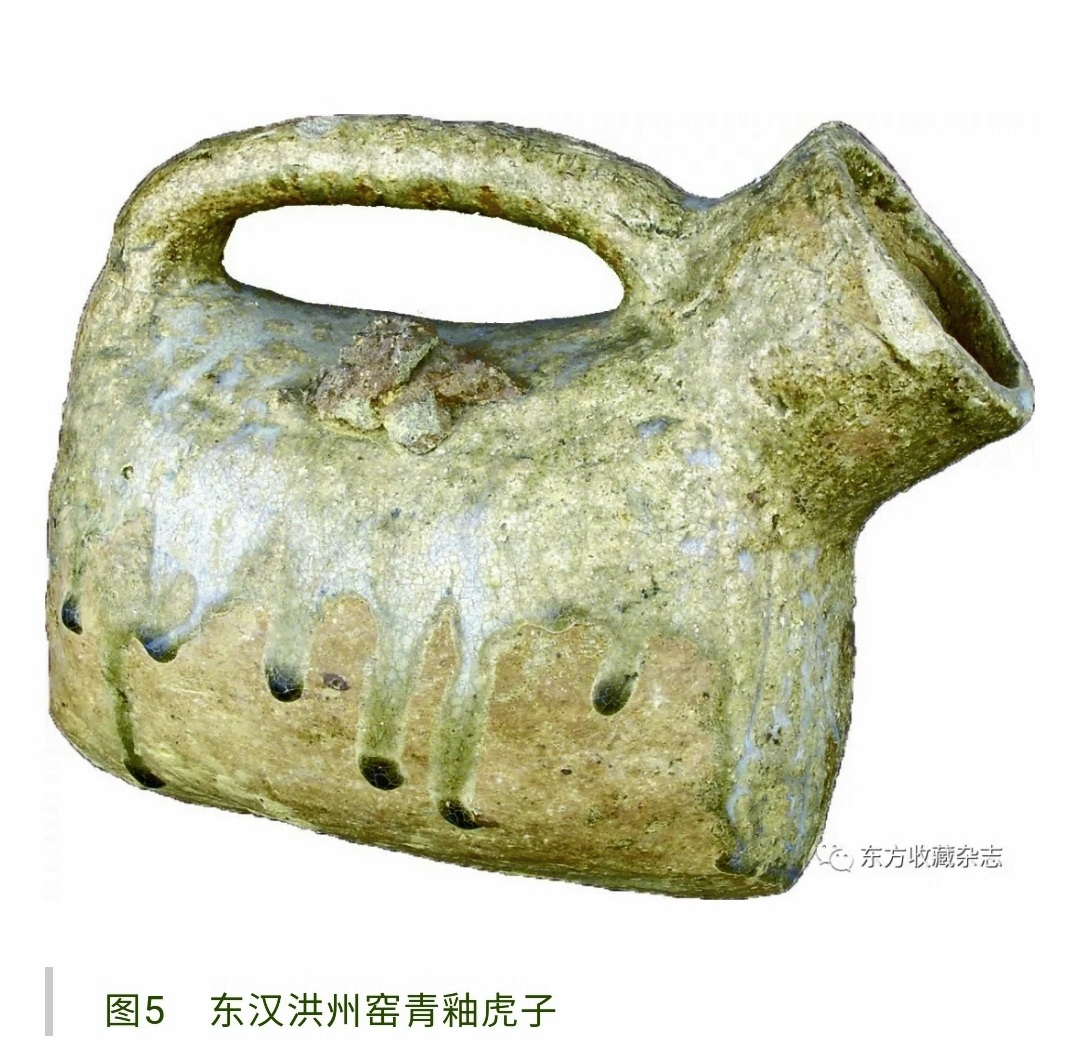 |
| Example of Han Hongzhou vessel |
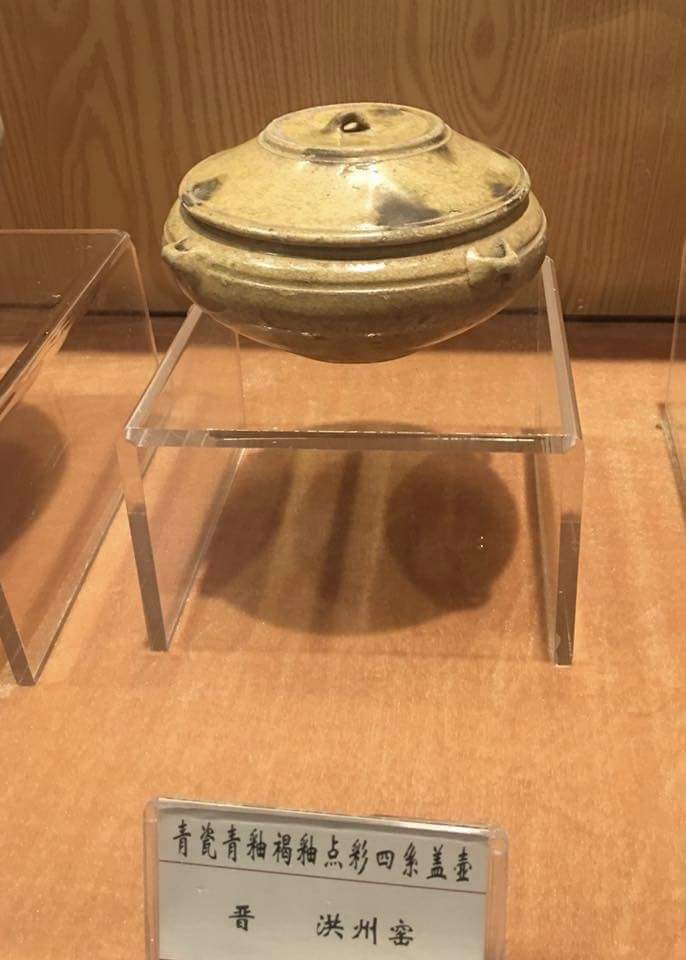 |
| Jn Hongzhou cover box with iron-brown spots |
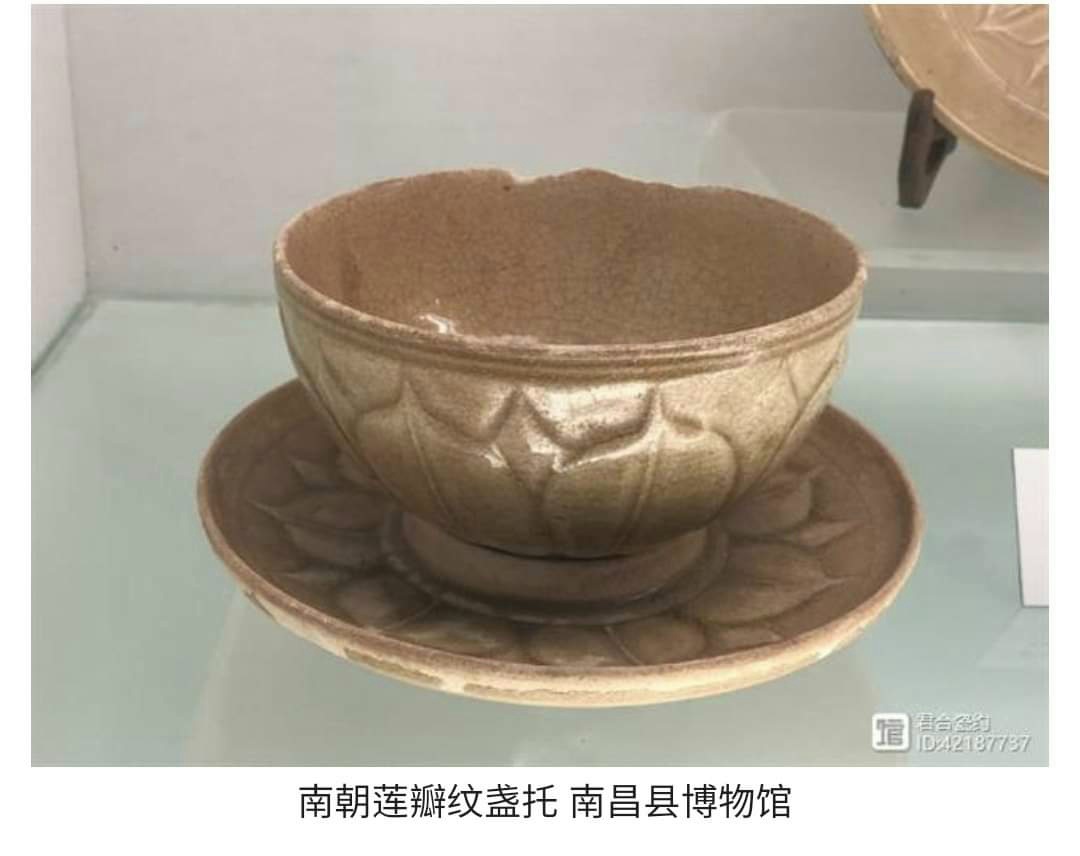 |
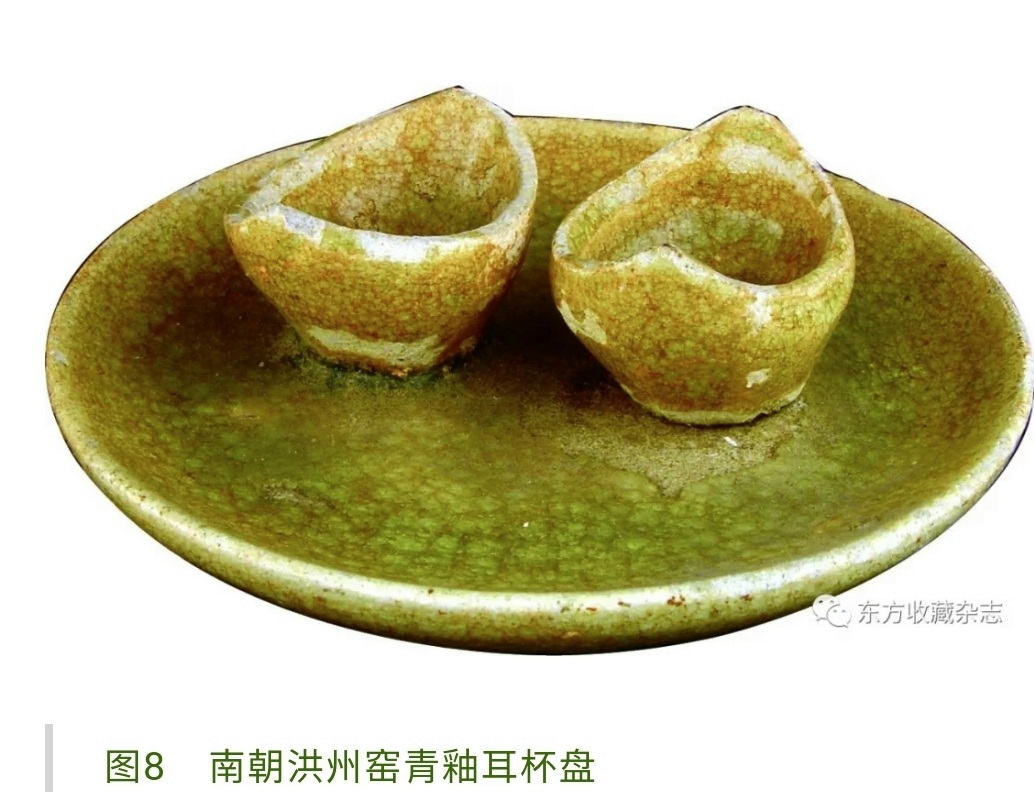 |
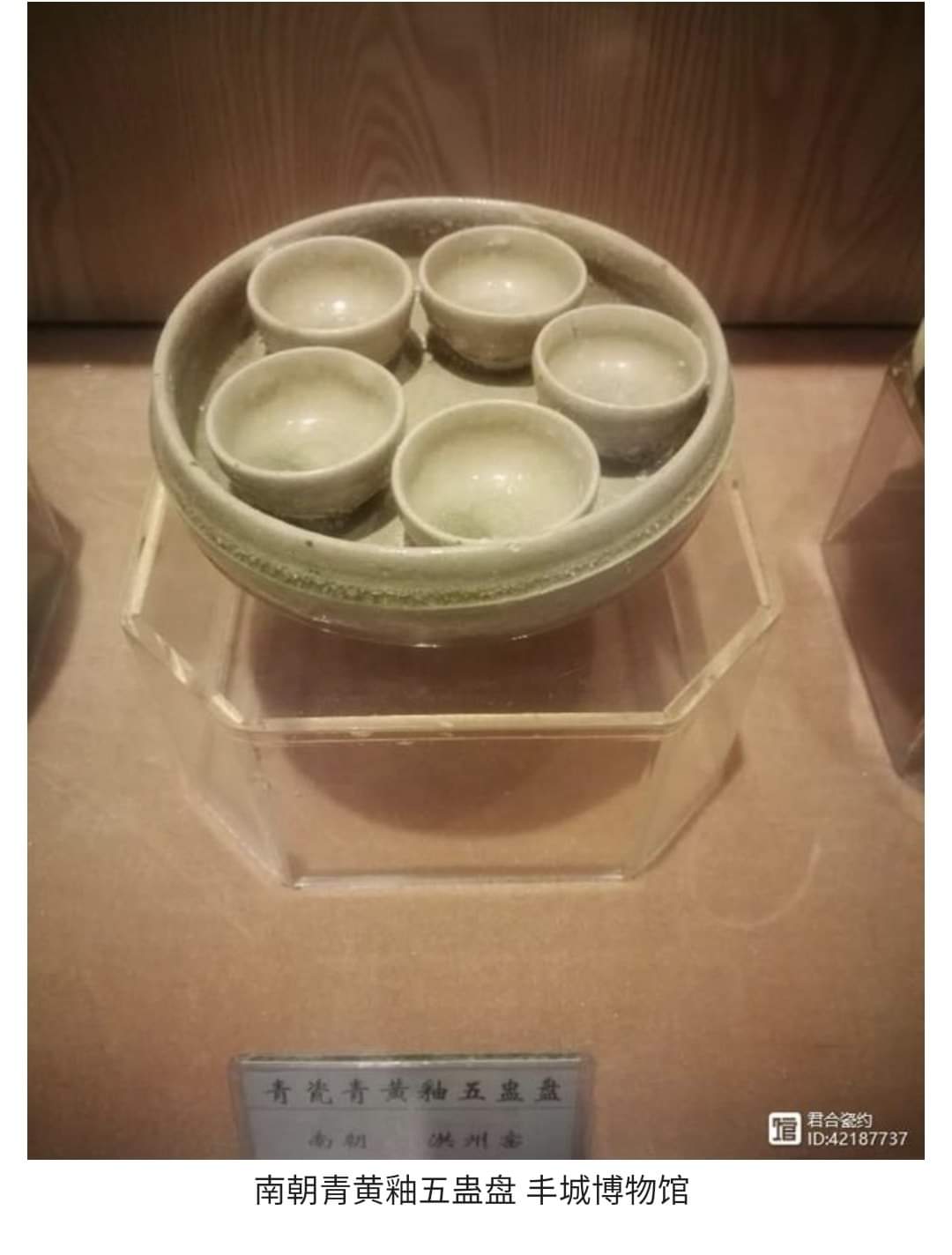 |
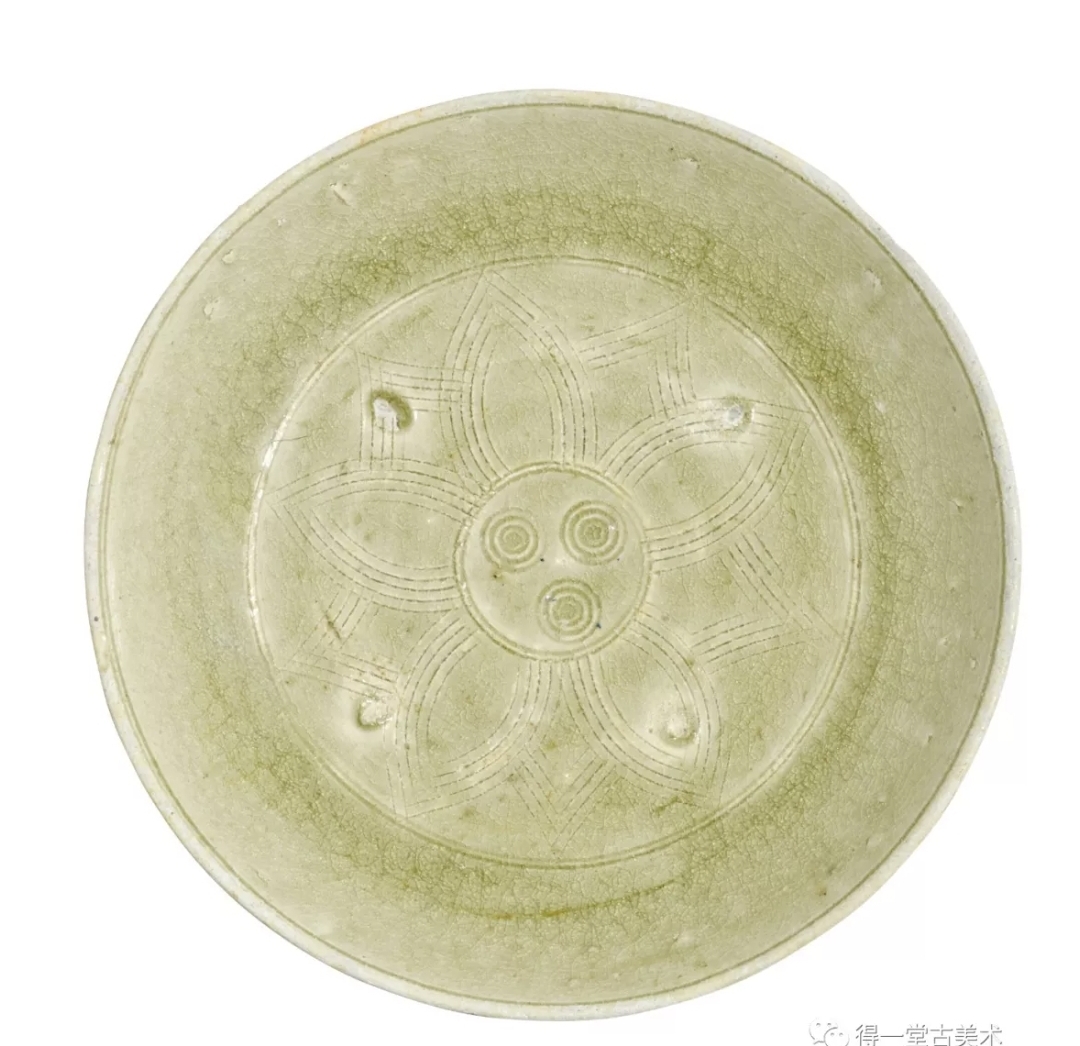 |
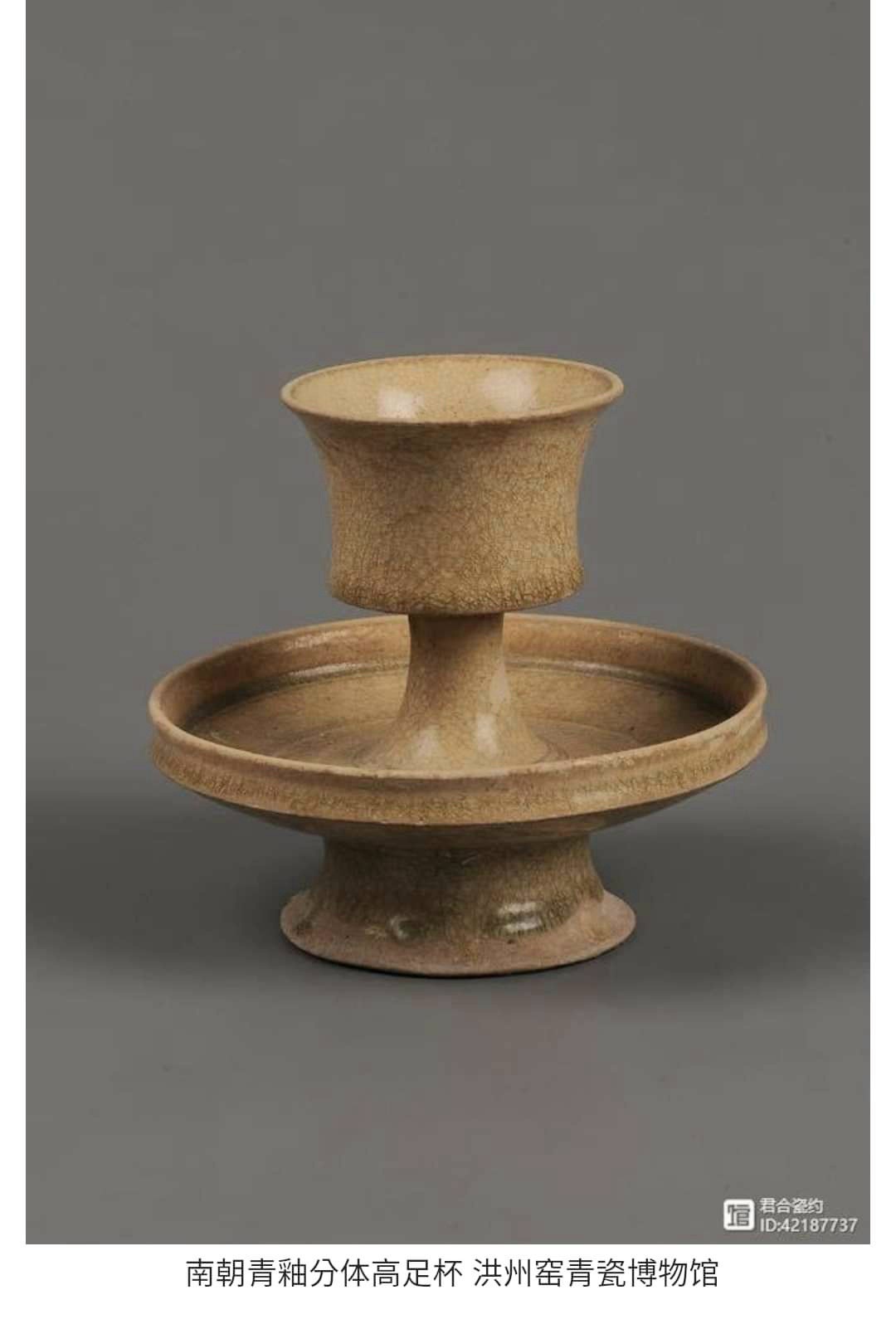 |
| Southern Dynasty Hongzhou examples |
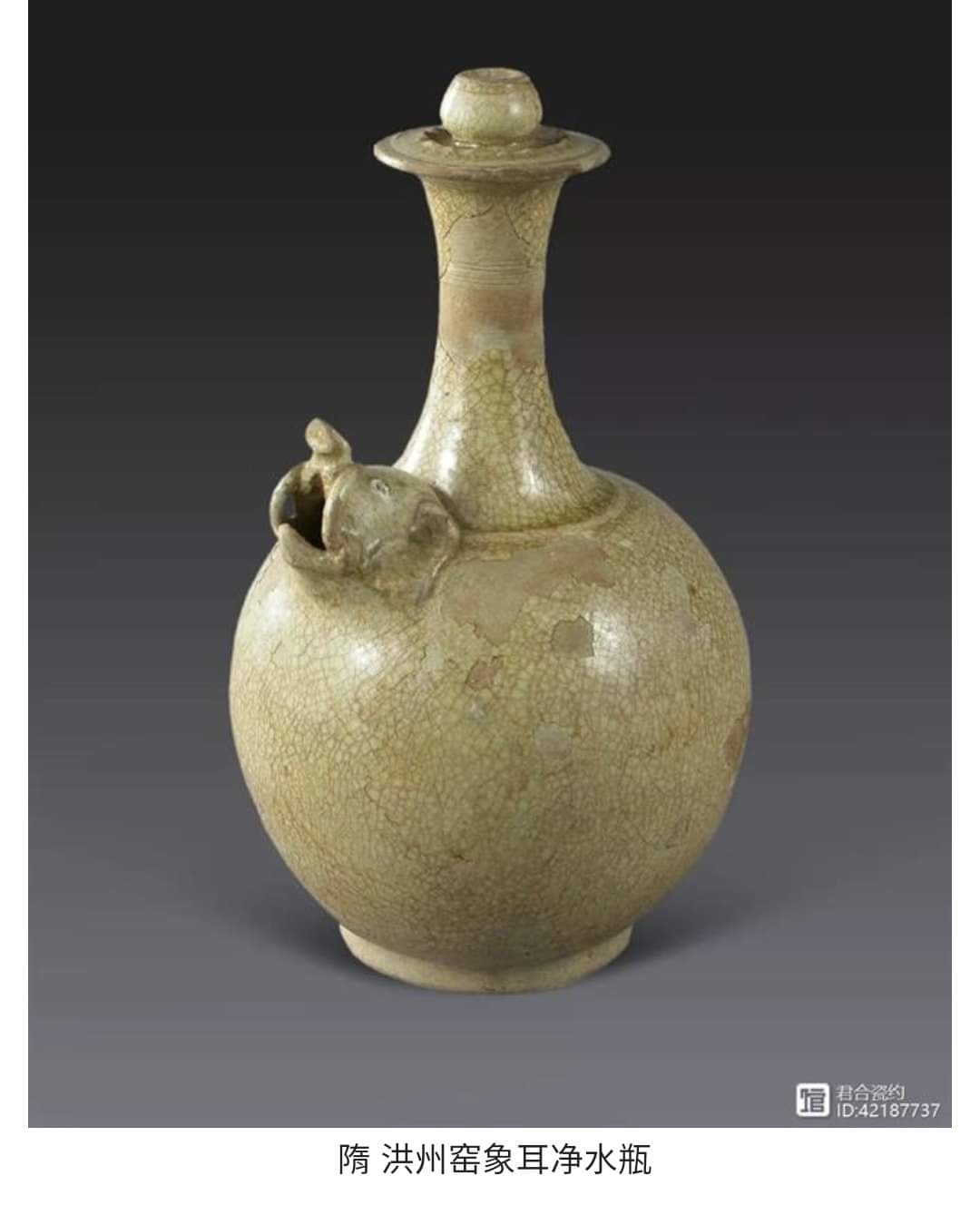 |
| Sui Dynasty Hongzhou kendi |
Northern China Green Glaze Production
In Northern China, Northern Dynasty era kiln sites producing greenware have been discovered in Shandong (山东), Shanxi (山西) , Hebei (河北) and Henan (河南). Two examples from Henan Anyang Xiangzhou(安阳相州) and Gongyi Baihe (巩义白河) kiln are shown below.
|
|
| Henan Gongyi Bai He kiln (Northern Wei Period) |
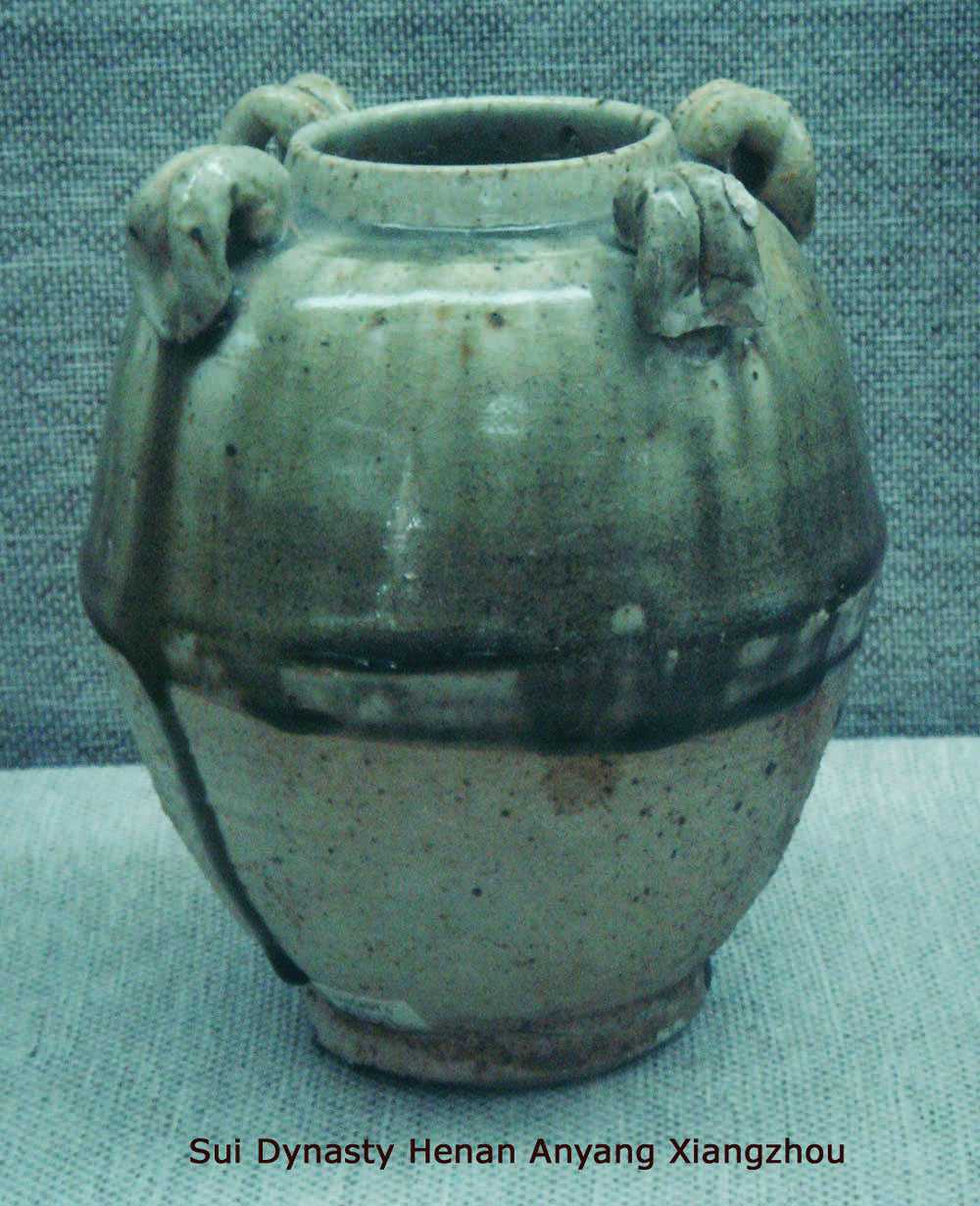 |
A distinctive feature of vessels from the North/South Dynasties was the strong influence of Buddhism as reflected in the vessels with lotus motif and a form of buddhist stylised flower called bao xiang hua (宝相花) and Ren Dong这(忍冬纹), ie honeysuckle motif. The most prominent vessel of the North Dynasties was the magnificent jar with body in lotus form. It is heavily potted with light grayish or greyish brown paste. The glaze is transparent and glassy. In Northern China, one kiln producing such wares was discovered at Zhai li kiln (寨里窑) in zi bo (淄博) in Shandong province. Hunan Yuezhou kiln is also known to produce such vessels.
Greenware (Celadon) with iron-brown painted motif
In 1983,at Nanjing (南京) Yuhuatai (雨花台), a celadon Jar with cover was recovered from a tomb. The tomb dated between the Three Kingdom to early Jin Period The body of the jar was applied with a slip before application of the glaze. The glaze is brownish in color. From the various characteristics, it is widely believed to be a product of Wuzhou (婺洲) kiln in Central Zhejiang. It was decorated with luted animal-face mask and buddha figure. The iron-brown motif included drawing some celestial beings. It is the earliest record of underglaze iron-brown decoration.
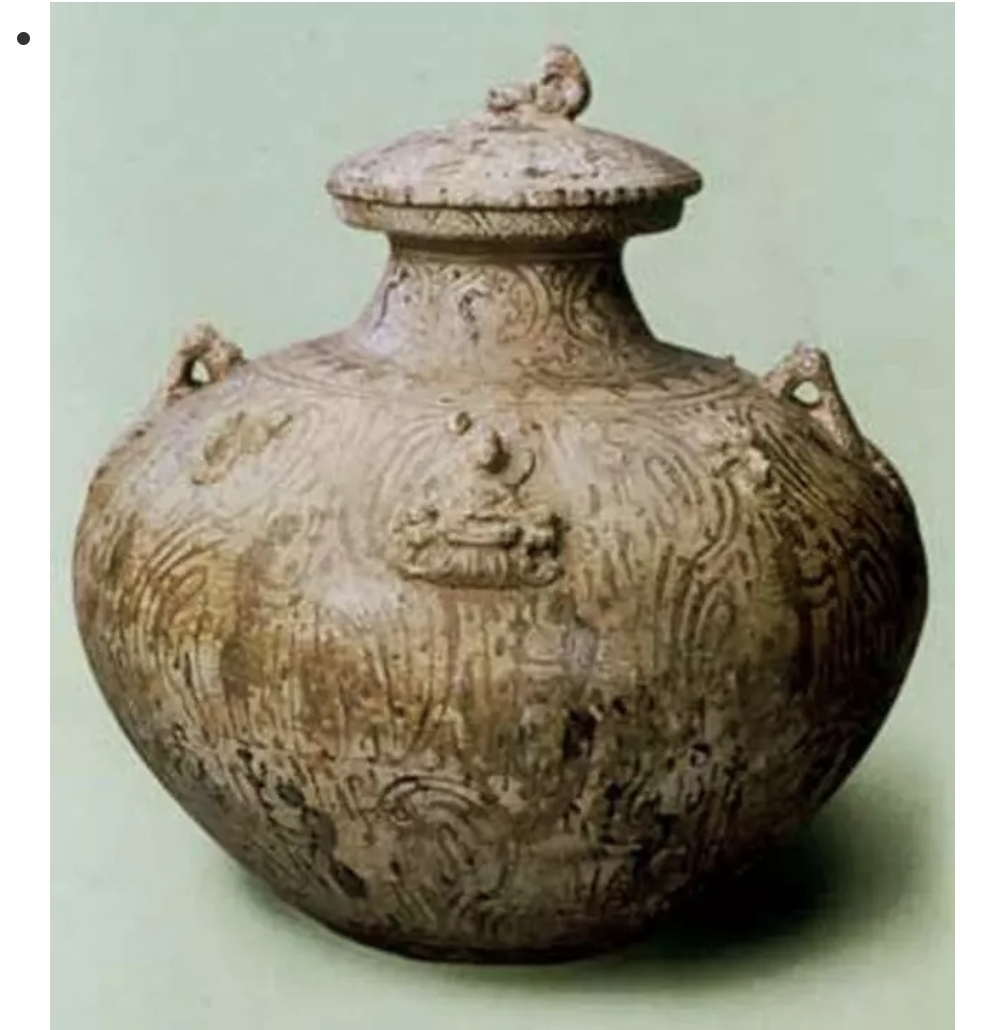 |
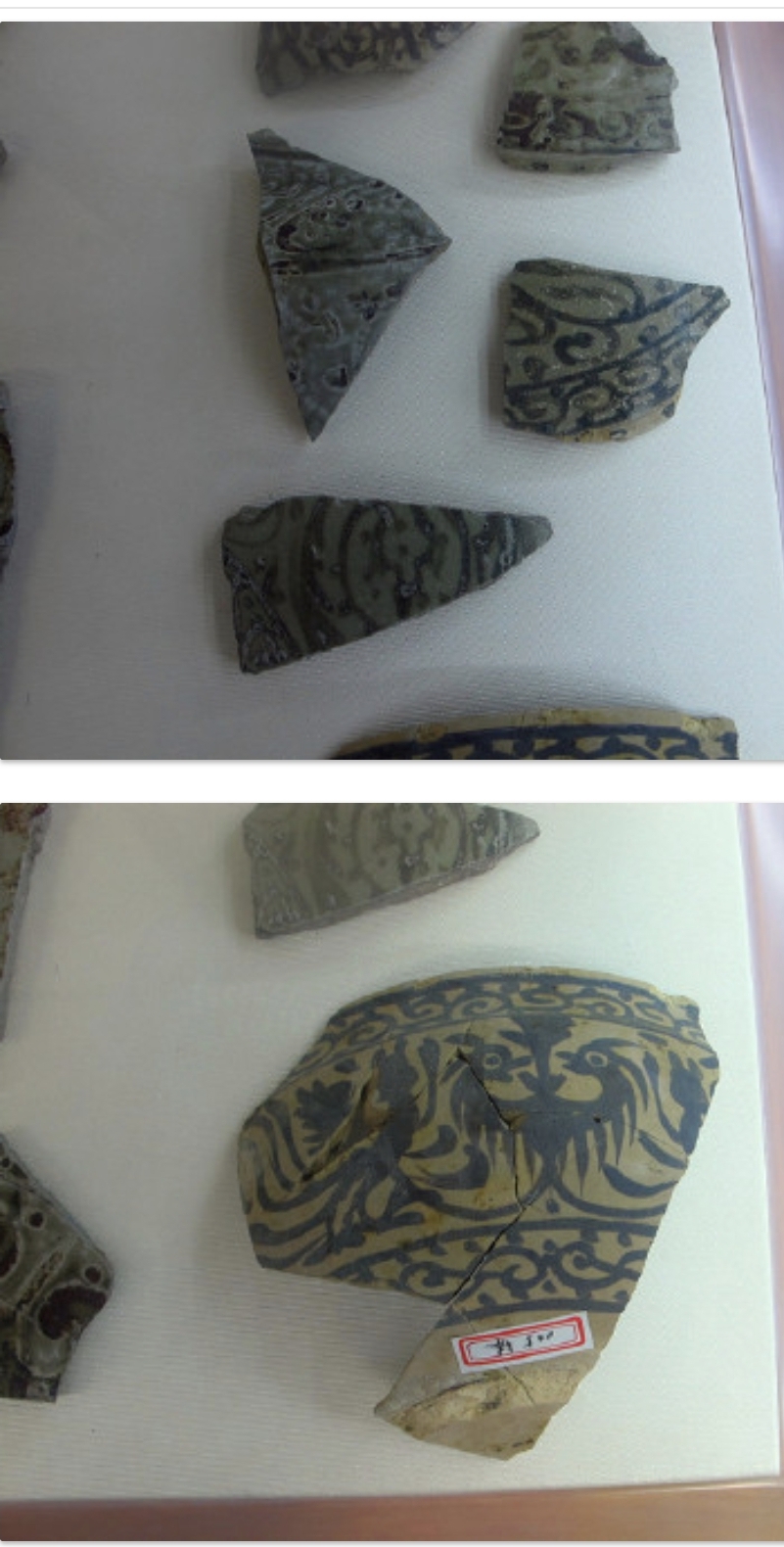 |
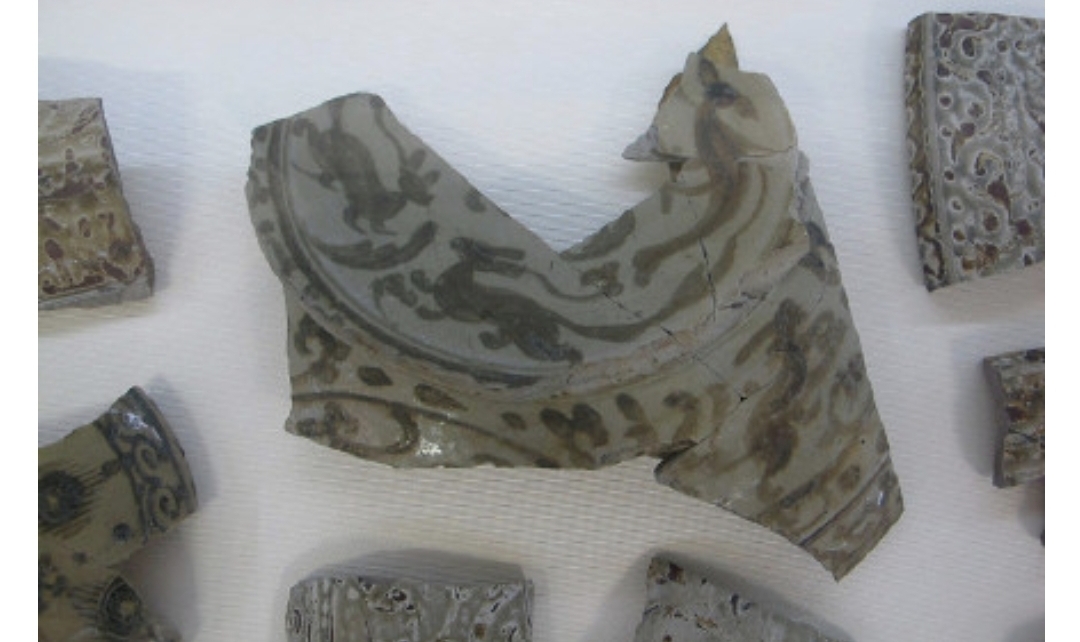 |
| The earliest published example of 3 Kingdom jar with underglaze black decoration found in Nanjing. Subsequently, Nanjing local collectors have also found some fragments with such decoration. |
Black Glaze wares
Black glaze wares were discovered in East Han tombs in Anhui, Hubei and Zhejiang Shangyu (上虞) Zhang zi shan kiln (帐子山窑), Deqing (德清二都乡黄角山窑). The kilns in Deqing produced mainly coarser bigger size black glaze jars and urns. The glaze is thick with crazing and tends to flake. Zhang zi shan kiln in Shangyu produced both greenwares and black glaze wares. There were more variety of black glaze wares including bowls, washers, jars and hu vases. Generally, the paste of the black glaze wares is more coarse. Black glaze also used iron oxide as colorant for the glaze. However, the content is higher than that for greenware and ranges from 4 to 9%. Both the greenwares and black glaze wares were fired simultaneously in the same kiln.
During the Six Dynasties, Deqing became the main centre for the production of black glaze wares. It also produced greenwares. The most striking examples were those Deqing chicken-head black glaze wares of the Jin period. Black glaze wares produced before Tang were comparatively low in volume. The mainstream production was greenwares.
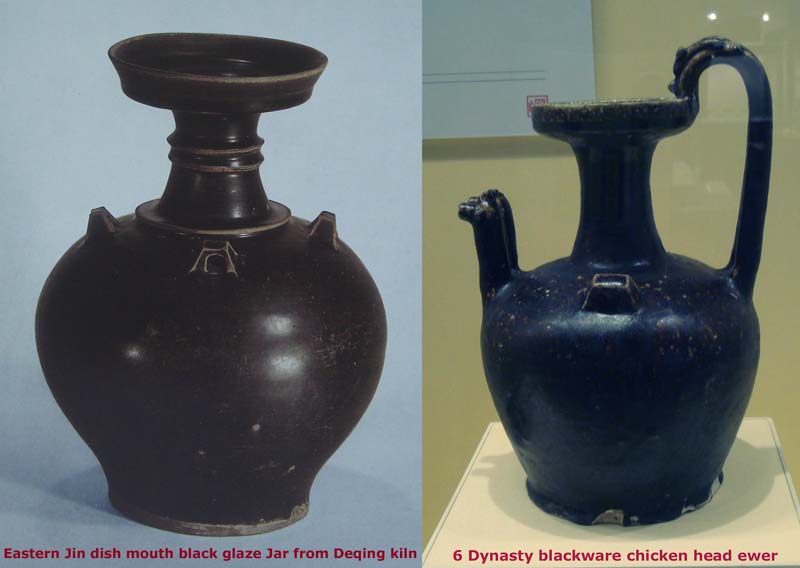
Northern Dynasty/Sui White Glaze wares
The earliest documented white wares were found in the tomb of Fan cui (范粹) dated 575 A.D (North Dynasty Bei Qi (北齐) and located in Anyang, Henan. There are those with fine or coarse body. They have a layer of white slip to whiten the body. The glaze is transparent and finely crackled with tinge of yellow or green.
Recent archaeological findings in Henan ancient Northern Wei Loyang city site indicated that the earliest white ware may be produced as early as early part of 6th century. Some of the white wares were probably produced in Henan kilns such as Anyang Xiangzhou(安阳相州) and Gongyi Baihe (巩义白河). In Baihe kiln, the stacking method was used for firing wares. Kiln wastage shows that white cup was placed on the top of green wares. Hence, the spur marks are seen on green wares and not the white ones. The white wares are more thinnly potted and the paste more whitish in colour.
|
|
| The early white wares still show clear greenish tone in the area where glaze pooled |
|
|
| Spur marks are found on the interior of green wares |
By Sui Dynasty, the quality of white wares have improved and quite a number were discovered in Sui tombs. The degree of whiteness has further improved. For example those from the Tomb of Li Jingxun (李静训) dated A.D 608 were fine and they have glaze white with hardly any trace of green/yellow.
Sui vessels were varied consisting of bowls, cups, vases , guan, candle stand, tripod censer, ewers and etc. Some striking examples of ewers have head head spout/dragon head handle and elephant head spout/dragon head handle.
In 1982 in the region between Hebei Lin cheng (临城) and Ne qiu (内丘), a Sui period kiln site that produced white wares was discovered at Jia cun (贾村). The shards included those with light grayish paste covered with white slip and others with white paste without the need for white slip. These were the early Xing wares. The quality of white wares from the Xing kilns were the best and it reached its greatest fame during the the Tang dynasty.
|
|
|
|
|
|
Updated: by NK Koh (30 Oct 2009) updated (18 May 2010, 5 Oct 2021)
References:
1 中国陶瓷 冯先铭 主编